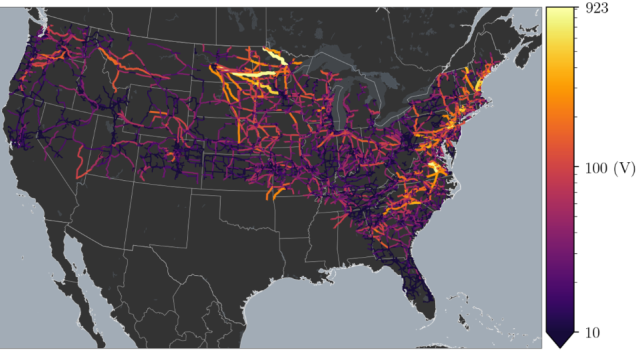A new map shows just how vulnerable some parts of the United States’ power grid might be to the impacts of a strong solar storm.
Solar storms are ejections of charged particles and their accompanying magnetic fields that the Sun occasionally shoots toward Earth. Though not otherwise harmful to life on Earth, a strong-enough storm could interfere with and even damage power grids. A map demonstrating which parts of the U.S. grid are most vulnerable to such a storm could help power companies better prepare.
Though the map leaves out a third of the country, it makes clear which power grids are particularly vulnerable to the impacts of a solar storm, including the U.S. East Coast and the Upper Midwest.
“For the time being… we can give a heads up to the power grid industry of where they need to investigate resilience to these storms,” Jeffrey Love, the study’s corresponding author from the United States Geological Survey, told Gizmodo.
When solar storms interact with Earth’s magnetic field, they have the potential to create electrical fields. These electrical fields can give rise to long periods of added electrical currents and voltages that transmission lines aren’t prepared to handle. For example, power distribution systems are typically designed to have alternating currents running through them—currents whose direction switches many times per second. But a solar storm could induce a single-direction current that persists for minutes or more. This could cause damage to transformers and other components, leading to widespread blackouts.
A power grid’s vulnerability is determined not only by the preparedness of the grid but also the composition of Earth itself. Love explained that the conductivity of the rock beneath the transmission lines could impact their susceptibility. Electricity flows more easily through more conductive rock, dissipating the electric fields and making the lines less likely to succumb to the effects of a storm. But such is not the case for more resistive rock, like the metamorphic rock upon which New York City is built, and the added electric fields are more likely to send current through the power lines instead.
This study incorporates data from 31 years of solar storm measurements taken by 24 geomagnetic observatories across North America, alongside measurements from 1,079 magnetotelluric sites, which record the electrical conductivity of the ground. Combined with power grid data, the researchers modelled the impact of a 100-year event, or the kind of strong solar storm that has a 1 per cent chance of occurring every year. They published their results recently in the journal Space Weather.
The map demonstrates high voltages running through power lines across the U.S., most notably in Minnesota, parts of the Mountain and Pacific Northwest, and east of the Appalachian Mountains. Love told Gizmodo that once the data becomes available, the team will map the remaining third of the country.
This kind of analysis is similar to other disaster estimates, such as FEMA’s flood zone designations. A power company could then take the data, run scenarios and simulations based on it, and determine which of its systems are in need of upgrades or further safeguards. The 2019 New York City blackout shined a spotlight on the fact that the city’s infrastructure is in need of modernising, solar storms or not.
So no, a solar storm isn’t going to harm you directly, but in a world dependent on power grids for pretty much everything, a strong solar storm could be devastating if we aren’t prepared.
